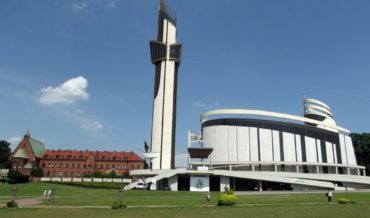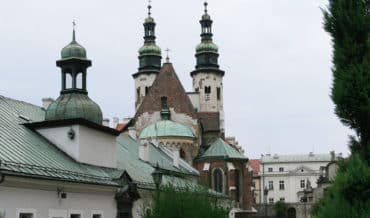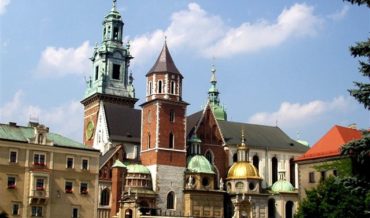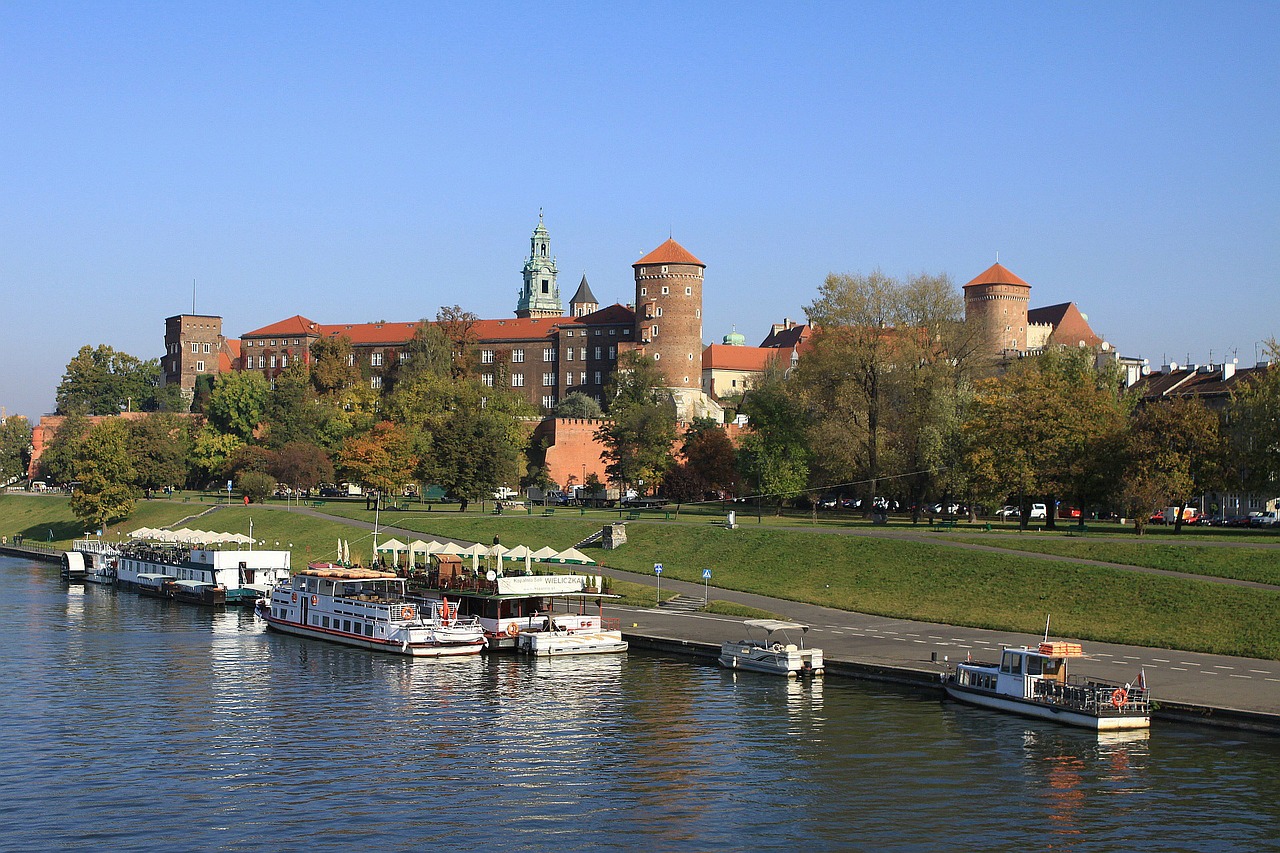Contents
- 1 Key Facts
- 2 Early Life and Noble Heritage
- 3 Educational Journey Across Medieval Europe
- 4 Return to Poland and Ecclesiastical Career
- 5 The Dominican Mission: Meeting Saint Dominic
- 6 Establishing the Dominican Order in Poland
- 7 Extensive Missionary Activities
- 8 Documented Miracles and Spiritual Phenomena
- 9 Death and Immediate Veneration
- 10 Canonization and Official Recognition
- 11 Architectural and Cultural Legacy
- 12 Contemporary Devotion and Modern Relevance
Key Facts
• Born: c. 1183 in the Opole region, Silesia
• Died: August 15, 1257 in Kraków
• Family: Noble Odrowąż family, influential in medieval Poland
• Education: Universities in Prague, Paris, and Bologna – doctorate in philosophy and theology
• Ordained by: Bishop Wincenty Kadłubek (later Saint Vincent Kadłubek)
• Major achievement: Established the Dominican Order in Poland and founded the first Dominican monastery in Kraków
• Canonized: April 17, 1594 by Pope Clement VIII
• Feast day: August 17 (August 16 in some regions)
• Patron saint: Poland, Lithuania, sailors, and those in danger of drowning
Saint Jacek (Saint Hyacinth) Odrowąż was a priest, Dominican friar, missionary, and doctor of theology who fundamentally transformed religious life in medieval Central Europe. Born around 1183 in the Opole region of Silesia, he died on August 15, 1257 in Kraków. His most significant achievement was bringing the Dominican Order to Poland and establishing the foundations of scholarly religious life that would influence the region for centuries.
Early Life and Noble Heritage
Saint Jacek originated from the Odrowąż family, one of medieval Poland's most powerful noble houses. The family's coat of arms became associated with numerous prominent figures throughout Polish history, and their substantial landholdings across Silesia and Lesser Poland provided young Jacek with exceptional educational opportunities rarely available in 13th-century Europe.
This noble heritage was crucial to his later success. The Odrowąż family's influence extended into both ecclesiastical and political circles, providing Jacek with the social standing, financial resources, and connections necessary to establish religious institutions and undertake extensive missionary journeys across Central and Eastern Europe.
Educational Journey Across Medieval Europe
Early Studies in Central Europe
Jacek's higher education began in Bohemia, where he studied at emerging academic centers. Prague was experiencing significant intellectual development during this period, coinciding with the broader European scholastic renaissance of the early 13th century that was revolutionizing theological and philosophical thought.
The University of Paris Experience
His studies continued at the University of Paris, then Europe's premier center of learning and theological scholarship. At Paris, Jacek encountered the works of leading scholastic masters and witnessed the intellectual debates shaping medieval Christianity. This Parisian experience proved crucial in developing both his theological expertise and his missionary commitment.
Academic Achievement in Bologna
The culmination of his educational journey occurred at the University of Bologna, where he earned a doctorate in philosophy and theology. Bologna's reputation for rigorous academic standards and innovative approaches to canonical law and theology made this achievement particularly significant, establishing Jacek among the most educated clergy of his era.
Return to Poland and Ecclesiastical Career
Ordination by a Future Saint
Upon returning to Poland, Jacek was ordained as a priest by Wincenty Kadłubek, Bishop of Kraków, who would later be canonized as Saint Vincent Kadłubek. This ordination created a remarkable connection between two future saints of the Polish Church and demonstrated the high regard in which Jacek was held by church leadership.
Bishop Wincenty Kadłubek was also a distinguished scholar and chronicler, author of the Chronica Polonorum (Chronicle of the Poles). Under his guidance, Jacek was appointed canon and preacher at Wawel Cathedral, the most prestigious ecclesiastical position in medieval Poland.
Canon at Wawel Cathedral
As canon and preacher at Wawel Cathedral, Jacek held one of the highest clerical positions in Poland. The cathedral, serving as the coronation site of Polish kings and the seat of bishops within the greater Wawel Castle complex, provided him with an influential platform to reach both nobility and common people. His sermons became renowned for their eloquence and theological depth, reflecting his extensive European education.
The Dominican Mission: Meeting Saint Dominic
The Pivotal Roman Encounter
The defining moment in Jacek's spiritual journey occurred during a pilgrimage to Rome around 1220, where he encountered Saint Dominic de Guzmán, founder of the Order of Preachers (Dominicans). Deeply moved by the Dominican commitment to preaching, scholarship, and evangelical poverty, Jacek received the Dominican habit directly from Saint Dominic himself.
According to the Acta Sanctorum, this meeting profoundly transformed Jacek's understanding of religious life, inspiring him to embrace the Dominican mission of combining rigorous intellectual formation with active pastoral ministry.
Establishing the Dominican Order in Poland
Founding the First Dominican House
Upon his return to Poland, Jacek undertook the monumental task of establishing the Dominican Order in Central Europe. Around 1221-1222, he founded the first Dominican monastery in Kraków at the Church of the Holy Trinity, creating a revolutionary center of learning and spiritual life that attracted scholars and pilgrims from across Europe.
The establishment of this Dominican presence involved several crucial achievements:
- Securing papal approval and episcopal support from successive Bishops of Kraków
- Obtaining royal patronage from Polish monarchs who recognized the order's value
- Recruiting and training local candidates for Dominican life
- Creating educational programs that served both religious and secular communities
Impact on Religious and Intellectual Life
The Dominican monastery founded by Saint Jacek became more than a religious house—it evolved into a center of learning that significantly contributed to Kraków's intellectual development. This foundation helped establish the scholarly tradition that would later culminate in the founding of the Jagiellonian University in 1364, making Kraków one of Central Europe's great centers of learning.
Extensive Missionary Activities
Geographic Scope of Evangelization
Saint Jacek's missionary work extended far beyond Poland's borders. According to canonization records preserved in the Acta Sanctorum, his evangelical journeys encompassed:
- Silesia and Greater Poland – consolidating Dominican presence in Polish territories
- Lithuania and Prussia – evangelizing among Baltic pagan populations
- Ruthenia and Kiev – establishing Dominican houses in Orthodox Christian territories
- Scandinavia – participating in northern European missionary efforts
Missionary Methodology
Jacek's approach to evangelization emphasized peaceful conversion rather than forced baptism, scholarly discourse alongside popular preaching, and respect for local customs where compatible with Christian doctrine. His multilingual abilities, developed through his European education, enabled effective communication with diverse populations across Central and Eastern Europe.
The missionary strategy employed by Saint Jacek included:
- Establishment of educational institutions alongside churches
- Training of local clergy to ensure continuity
- Integration of indigenous customs with Christian liturgical practices
- Emphasis on social service and care for the poor and sick
Documented Miracles and Spiritual Phenomena
Miracles Recorded in Canonization Proceedings
The papal bull of canonization issued by Pope Clement VIII in 1594 documents several miracles attributed to Saint Jacek, carefully investigated during the canonization process:
- Resurrection miracles: Restoring life to individuals who had drowned in the Vistula River
- Healing miracles: Restoring sight to the blind and curing terminally ill patients
- Nature miracles: Calming dangerous storms during missionary travels
- Providential miracles: Multiplying food during famines and times of scarcity
The Legend of Kiev
One of the most celebrated accounts associated with Saint Jacek involves his escape from Kiev during the Mongol invasion of 1240. According to hagiographical sources in the Acta Sanctorum, while celebrating Mass, he reportedly heard a voice from a statue of the Virgin Mary instructing him to carry both her image and the Blessed Sacrament to safety. The account describes his miraculous crossing of the Dnieper River while bearing both sacred objects.
Death and Immediate Veneration
Saint Jacek died on August 15, 1257—the Feast of the Assumption of the Blessed Virgin Mary—in Kraków, after dedicating his life to expanding the Church's mission in Central Europe. He was interred in the Holy Trinity Church (Dominican Church) in Kraków, the very monastery he had established decades earlier.
The Holy Trinity Church immediately became a pilgrimage destination, with the faithful seeking his intercession and reporting miraculous healings at his tomb. The church's location in Kraków's medieval center made it accessible to both local devotees and international pilgrims traveling through Central Europe.
Canonization and Official Recognition
The Path to Sainthood
The canonization process for Saint Jacek began in the decades following his death, reflecting widespread recognition of his sanctity. After extensive investigation of his life, documented miracles, and lasting impact on the Church, Pope Clement VIII canonized him on April 17, 1594.
The papal bull of canonization specifically praised his role in establishing the Dominican Order in Poland, his scholarly achievements, missionary success, and the verified miracles attributed to his intercession.
Liturgical Status and Patronage
- Feast Day: August 17 (Roman Catholic Calendar)
- Patronage: Poland, Lithuania, sailors, those in danger of drowning, and Dominican missionaries
- Liturgical Rank: Memorial in the universal Roman Catholic calendar
Architectural and Cultural Legacy
The Dominican Heritage
The Gothic Church of the Holy Trinity founded by Saint Jacek remains one of Kraków's most significant religious monuments. Rebuilt and expanded over the centuries, it houses remarkable works of medieval and baroque art while serving as a living testament to his foundational achievements.
Educational Influence
The scholarly tradition established by Saint Jacek directly contributed to Kraków's emergence as a major center of learning. His emphasis on combining rigorous theological study with practical pastoral care became a defining characteristic of Polish Catholic education and influenced the intellectual culture throughout the region.
Contemporary Devotion and Modern Relevance
Current Veneration
Modern devotion to Saint Jacek continues throughout Poland, Lithuania, and regions where he conducted missionary work. His intercession is particularly sought for:
- Protection during travel, especially sea voyages
- Success in academic pursuits and scholarly endeavors
- Strengthening of faith during persecution or difficulty
- Ecumenical understanding between Eastern and Western Christian traditions
The legacy of Saint Jacek joins those of other Polish saints like Saint John Kanty and Blessed Queen Jadwiga in demonstrating Poland's rich spiritual heritage. His influence extended throughout medieval Kraków, from the scholarly atmosphere that pervaded the Old Town to the vibrant religious life that flourished in areas like the Kazimierz district.
Historical Significance
Saint Jacek's life exemplifies the medieval synthesis of noble heritage with religious service, scholarly achievement with missionary zeal, and local commitment with universal vision. His establishment of the Dominican Order in Poland created enduring institutions that continue serving the Church and society today, securing his position as one of the great figures in both Polish history and the broader Catholic Church.
The scholarly and missionary legacy of Saint Jacek demonstrates how individual dedication to learning and evangelization can transform entire regions, making him a particularly relevant model for contemporary efforts at educational excellence and cross-cultural dialogue. His story continues to inspire visitors to Kraków who explore sites from the historic Main Square to institutions like the National Museum and the Historical Museum of Kraków, where his legacy is preserved and celebrated.
Modern Poland continues to honor his memory, and his influence remains part of the nation's spiritual identity alongside more recent figures like John Paul II. Saint Jacek's connection to the broader geographic region, including areas that extend toward the Polish Jurassic Highland, reflects the wide-reaching impact of his missionary work throughout medieval Central Europe.



